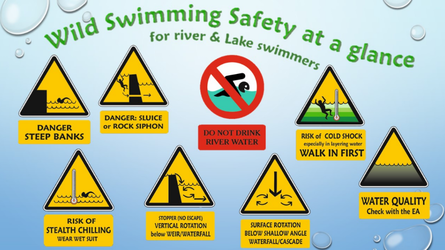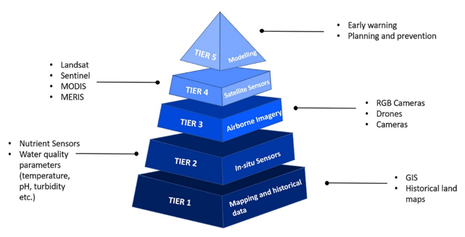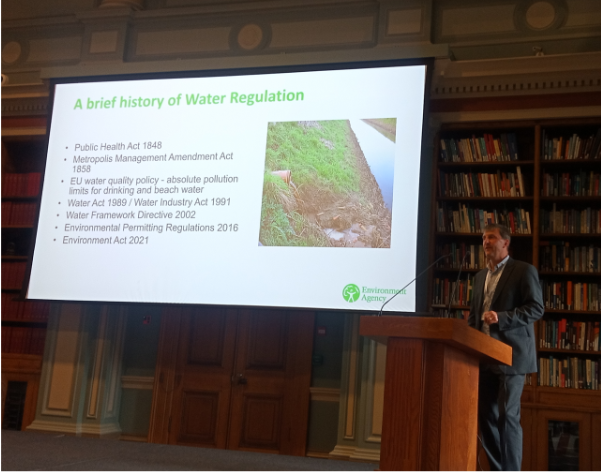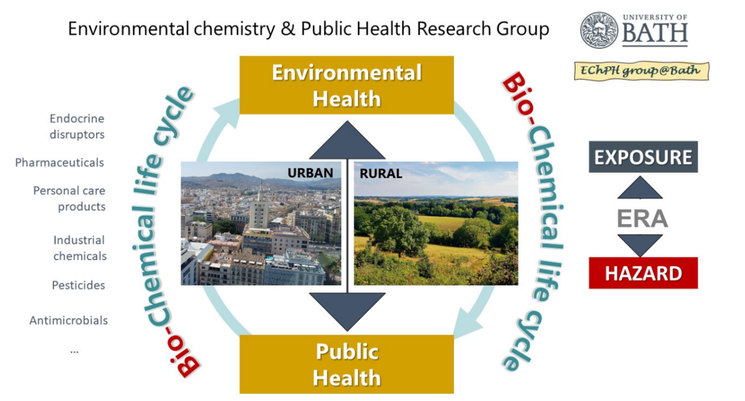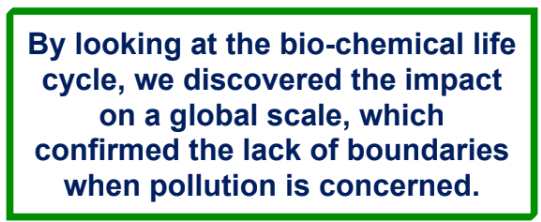- Home
- About
- Environmental Briefs
-
Distinguished Guest Lectures
- 2023 Water, water, everywhere – is it still safe to drink? The pollution impact on water quality
- 2022 Disposable Attitude: Electronics in the Environment >
- 2019 Radioactive Waste Disposal >
- 2018 Biopollution: Antimicrobial resistance in the environment >
- 2017 Inside the Engine >
- 2016 Geoengineering >
- 2015 Nanomaterials >
- 2014 Plastic debris in the ocean >
- 2013 Rare earths and other scarce metals >
- 2012 Energy, waste and resources >
- 2011 The Nitrogen Cycle – in a fix?
- 2010 Technology and the use of coal
- 2009 The future of water >
- 2008 The Science of Carbon Trading >
- 2007 Environmental chemistry in the Polar Regions >
- 2006 The impact of climate change on air quality >
- 2005 DGL Metals in the environment: estimation, health impacts and toxicology
- 2004 Environmental Chemistry from Space
- Articles, reviews & updates
- Meetings
- Resources
- Index
Water, water, everywhere – is it still safe to drink? The pollution impact on water quality.
The Environmental Chemistry Group’s 2023 Distinguished Guest Lecture and Symposium was held on the 22nd of May at Burlington House. The event highlighted societal concerns over water quality and examined how we can monitor and regulate water standards to enhance environmental and public health. The ECG Distinguished Guest Lecture was given by Professor Barbara Kasprzyk-Hordern
(University of Bath).
(University of Bath).
|
24 delegates attended in person and a further nine joined the online portion of this first hybrid Distinguished Guest Lecture event.
The symposium was opened by Dr Stephanie Powley (Environmental Chemistry Groups Website and Social Media Coordinator), who introduced the first speaker Mr Rob Fryer, who presented ‘Rivers of life?’. Through an extensive exploration of open water swimming and access, it was shown that open water swimming is a historical pastime, however, the quality of our waters is now being challenged. |
The power of media was explored, particularly how false news has encouraged people not to swim in both dangerous and clean rivers. The dangers of wild swimming are extensive; however, many risks result from subsidiary land activities.
Mr Fryer highlighted his belief that the quality of the environment is intrinsically linked to the quality of life. Compared swimming in rivers to walking in Eryri (Snowdonia) National Park highlighting that eight people die every year walking here. But there is too much commercial interest to allow for the restriction of walking in Eryri, whereas river and lake swimming are more informal and less commercialised.
In 1999, Waterlog was published, by Roger Diken, where he coined the term “wild swimming”. It was very much a term for swimming in lakes and rivers in the UK, but now it is just a denomination of swimming. At the release of the book, the populous took to wild swimming, enthusiastically.
Mr Fryer highlighted his belief that the quality of the environment is intrinsically linked to the quality of life. Compared swimming in rivers to walking in Eryri (Snowdonia) National Park highlighting that eight people die every year walking here. But there is too much commercial interest to allow for the restriction of walking in Eryri, whereas river and lake swimming are more informal and less commercialised.
In 1999, Waterlog was published, by Roger Diken, where he coined the term “wild swimming”. It was very much a term for swimming in lakes and rivers in the UK, but now it is just a denomination of swimming. At the release of the book, the populous took to wild swimming, enthusiastically.
The second speaker, Professor Fiona Regan (Dublin University), presented ‘Monitoring pollution and its impact on water quality using innovative tools’. Here, we were taken on a journey through water quality monitoring from the laboratory to the field; exploring how technology can lead to better decision-making to improve our environment. Professor Regan discussed the benefits of implementing sensors to gather multi-parameter information for water monitoring and management; how we can integrate these factors to inform management and prevention measures, and how emerging technologies can aid in combating climate change-related events (e.g. flooding and heat waves) as well as aiding in different sectors, such as aqua and agriculture (e.g. excessive algal bloom growth and phosphorus levels in waters).
|
By using technologies such as in situ sensors and satellites, Professor Regan’s team plan to integrate a wealth of different data types to make these predictions. They have also been developing sensors for use in riverine systems for years, starting with tidal trends and looking at basic parameters such as pH, BOD and conductivity. An example was presented where Artificial Intelligence (AI) could predict events through hindsight studies, such as monitoring clusters of basic parameters such as dissolved oxygen, salinity, and temperature. These data showed fluctuations that resulted in an algal bloom in their watershed. If the team had been alerted by AI about warning fluctuations, they would have known to look at chloroform levels, and could have predicted the algal bloom.
|
She reported the development of a continuous fluorometric method for measuring E. coli (a measure of water quality from an ecological perspective). This technology was predicted to be used as a health alert device; however, more discussions are required for use in regulatory monitoring.
There was also potential to use these technologies for monitoring emerging contaminants, particularly organic
compounds. These included pesticides, pharmaceuticals, personal care products, hormones, plasticisers, food additives, surfactants, and disinfectants. There are, however, analytical challenges. In order to take monitoring devices to carry out in situ analysis, a multidisciplinary approach is needed.
Professor Regan discussed her work on developing a bioassay in the field. Through the development of a cDNA analyser, the team applied an isothermal strategy to bypass Q-PCR requirements, and by using Cas12a single-stranded DNase activity, the team were able to utilise fluorescence detection for targeted interactions.
Other projects from Professor Regan’s group include the identification of anti-depressants in water systems, and assessing the negative effects these drugs can have on the ecosystem.
After a break for networking and coffee, Laura Alcock, Environmental Chemistry Group’s Secretary and event organiser, introduced the third speaker, Dr John Collins, a Deputy Director in the Chief Scientist’s Group at the Environment Agency in
England. Dr Collins presented ‘Regulating for the Water Environment’, highlighting the importance of combining these two processes, and giving us a history of water regulation, where our current framework is, and what challenges we face.
There was also potential to use these technologies for monitoring emerging contaminants, particularly organic
compounds. These included pesticides, pharmaceuticals, personal care products, hormones, plasticisers, food additives, surfactants, and disinfectants. There are, however, analytical challenges. In order to take monitoring devices to carry out in situ analysis, a multidisciplinary approach is needed.
Professor Regan discussed her work on developing a bioassay in the field. Through the development of a cDNA analyser, the team applied an isothermal strategy to bypass Q-PCR requirements, and by using Cas12a single-stranded DNase activity, the team were able to utilise fluorescence detection for targeted interactions.
Other projects from Professor Regan’s group include the identification of anti-depressants in water systems, and assessing the negative effects these drugs can have on the ecosystem.
After a break for networking and coffee, Laura Alcock, Environmental Chemistry Group’s Secretary and event organiser, introduced the third speaker, Dr John Collins, a Deputy Director in the Chief Scientist’s Group at the Environment Agency in
England. Dr Collins presented ‘Regulating for the Water Environment’, highlighting the importance of combining these two processes, and giving us a history of water regulation, where our current framework is, and what challenges we face.
|
With current news often highlighting the impact of river and coastal pollution, Dr Collins discussed the importance of regulation and its associated aspects such as legal requirements, advice and guidance, incentivisation, permitting, compliance, enforcement, and non-regulatory partnerships, for an improved future.
Currently, the Water Framework Directive (WFD) and river basin management plans go hand in hand to improve water quality in the environment. Although just 14% of English rivers are considered “ecologically Good” according to the WFD, there are a range of parameters that state otherwise, e.g. individual tests (with 77% passed), ammonia and invertebrate levels are on the rise. It is also important to note that this approach does work with a significant reduction in serious pollution incidents, down from over 500 cases in 1995 to less than 100 in 2021. This is further reflected in an increase in the “excellent” status of bathing waters. |
There remains a struggle to meet targets due to anthropogenic activities such as physical modifications, wastewater production, agricultural and rural land activities, and the introduction of non-native invasive species. This, combined with additional challenges such as ageing infrastructures, climate change, population growth, and cost of living, has driven the EA to implement further policies. This includes a 25-year environmental plan: the Environmental Act 2021, Environmental improvement plan, and integrated plan for water (published by DEFRA) – where they hope to “develop a suite of new policy interventions designed to transform how we manage the water system in a holistic way".
With agriculture considered one of the largest contributors to water pollution, the EA has taken steps to try to combat this, including through increased inspections, incentive schemes such as silage stores, and by working with local task forces.
With agriculture considered one of the largest contributors to water pollution, the EA has taken steps to try to combat this, including through increased inspections, incentive schemes such as silage stores, and by working with local task forces.
Our 2023 Distinguished Guest Lecture was delivered by Professor Barbara Kasprzyk-Hordern, whose research focuses on interrelated areas of the environmental, analytical and water sciences. Combining these three disciplines, Professor Barbara Kasprzyk-Hordern reviewed her work on ‘water fingerprinting’ for assessments of environmental and public health. By looking at the bio-chemical life cycle, the impact of pollution on a global scale, irrespective of national boundaries, is revealed. Importantly, there was a need to discover how this impacted humans directly, and Professor Kasprzyk-Hordern discussed the advantages of using wastewater based epidemiology.
This process provided a comprehensive, continuous, anonymous, near real-time approach that ensured objectivity and unbiased results. Such research demonstrated the ability to map the spatial and temporal distribution of specific drugs or chemicals at a community level. This, in turn, could inform key stakeholders through a One Health approach, which included mixing different sciences (natural, social, medical and engineering), locations (e.g. Europe, Africa, America, Asia), and industrial sectors (NGOs, Government, Industry).
Professor Kasprzyk-Hordern explained how a One Health framework can provide a holistic evaluation process of combined community and environmental risks. She demonstrated multiple case studies in which water treatment works were perfect model systems that influenced water quality. Her team were also able to select sampling sites which would, in turn, enable them to represent the output of different chemical groups from a community level.
Professor Kasprzyk-Hordern explained how a One Health framework can provide a holistic evaluation process of combined community and environmental risks. She demonstrated multiple case studies in which water treatment works were perfect model systems that influenced water quality. Her team were also able to select sampling sites which would, in turn, enable them to represent the output of different chemical groups from a community level.
|
Through extensive analysis, Professor Kasprzyk-Hordern examined a current global issue – antimicrobial resistance. Research to date shows through resistant gene identification, the endemic correlated to communities, as opposed to antibiotic levels within the surrounding environment. This suggested that there are other drivers for resistance such as activities related to specific communities, for example, agricultural, urban, or rural settings. It is suspected that there is an issue in that the fluctuations of these two aspects (antimicrobial resistance and community activity) are set in different timescales. Antibiotics showed short-term variations, but antibiotic
resistance genes showed much longer-term trends and variations. |
The question was raised over whether Bisphenol A exposure is really below threshold levels, as samples are not taken from the requisite representative thousands of individuals. WBE supported the analysis of this.
Biomarkers rather than BPA were measured in the wastewater to determine how much of the material present was there as a result of human/animal exposure to BPA.
This approach can also enable identification of exposure markers through daily loads. Genetic markers were the most informative, with “hot spots” of infection showing that different communities suffer from different infections at different times. This information could help to deliver rapid response strategies, and also provides the basis for tackling future pandemics. A problem aspect of this process is that it is incredibly data heavy, making it both time-consuming and costly. However, the hope is that these discoveries will enable a cost-effective monitoring process that can combat antimicrobial resistance, climate change and many more global events.
This talk concluded a thought-evoking day of science and highlighted the importance of a one-health approach being required for future environmental security.
Laura Alcock presented Professor Kasprzyk-Hordern with the Distinguished Guest Lecturer’s medal and opened the floor to general discussion before closing the event.
Biomarkers rather than BPA were measured in the wastewater to determine how much of the material present was there as a result of human/animal exposure to BPA.
This approach can also enable identification of exposure markers through daily loads. Genetic markers were the most informative, with “hot spots” of infection showing that different communities suffer from different infections at different times. This information could help to deliver rapid response strategies, and also provides the basis for tackling future pandemics. A problem aspect of this process is that it is incredibly data heavy, making it both time-consuming and costly. However, the hope is that these discoveries will enable a cost-effective monitoring process that can combat antimicrobial resistance, climate change and many more global events.
This talk concluded a thought-evoking day of science and highlighted the importance of a one-health approach being required for future environmental security.
Laura Alcock presented Professor Kasprzyk-Hordern with the Distinguished Guest Lecturer’s medal and opened the floor to general discussion before closing the event.

